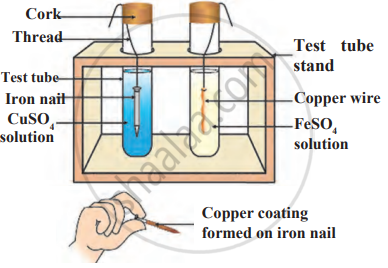Advertisements
Advertisements
प्रश्न
Write the chemical equation for the event.
A reaction was brought about between ferric oxide and aluminum.
उत्तर
Aluminium is more reactive than iron. Aluminium metal replaces iron from ferric oxide to form aluminium oxide and iron
Chemical Equation: \[2Al + F e_2 O_3 \to A l_2 O_3 + 2Fe\]
APPEARS IN
संबंधित प्रश्न
Give one example each of which illustrates the following characteristics of a chemical reaction:
evolution of a gas
How will you obtain Silver chloride from silver nitrate.
Also give balanced equations for the reactions
How will you obtain Zinc chloride from zinc.
Also give balanced equations for the reactions
What do you observe when Magnesium ribbon is burnt in oxygen.
Write chemical equation for the event.
Aluminium came in contact with air.
Write chemical equation for the event.
Electrolysis of alumina is done.
Divide the metals Cu, Zn, Ca, Mg, Fe, Na, Li into three groups, namely reactive metals, moderately reactive metals and less reactive metals.
Give a balanced equation for the reversible catalytic reaction involving nitrogen as one of the reactants.
Select the correct answer for the statement given below:
The catalyst used in the catalytic reaction involving the reactants nitrogen and hydrogen.
Classify the following metals based on their reactivity.
Cu, Zn, Ca, Mg, Fe, Na, Li, Hg
| More reactive | Moderately reactive | Less reactive |
Explain the following reaction with the balanced equation.
Magnesium reacts with dil HCl
Explain the following reaction with the balanced equation.
Sulphur burns in air
Observe the following diagram and identify the type of reaction and write observation.

Compound X and aluminium are used to join railway tracks.
- Identify the compound X
- Name the reaction
- Write down its reaction.
An element A reacts with water to form a compound B which is used in white washing. The compound B on heating forms an oxide C which on treatment with water gives back B. Identify A, B and C and give the reactions involved.
Give the steps involved in the extraction of metals of low and medium reactivity from their respective sulphide ores.
Explain the following
- Reactivity of Al decreases if it is dipped in HNO3
- Carbon cannot reduce the oxides of Na or Mg
- NaCl is not a conductor of electricity in solid state whereas it does conduct electricity in aqueous solution as well as in molten state
- Iron articles are galvanised.
- Metals like Na, K, Ca and Mg are never found in their free state in nature.
Of the three metals X, Y and Z. X reacts with cold water, Y with hot water and Z with steam only. Identify X, Y and Z and also arrange them in order of increasing reactivity.
